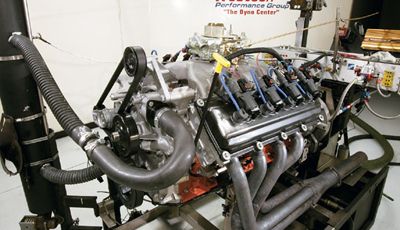
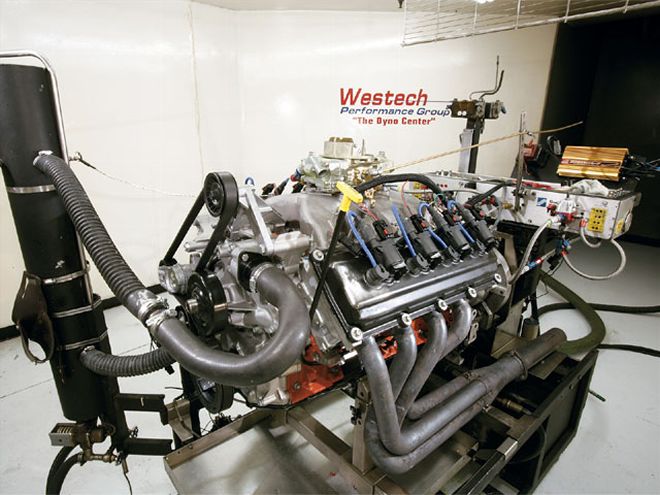
Without a doubt, looking back at the last three decades, the biggest development to come out of Chrysler was the introduction of the modern Hemi in 2003. Up until then, Mopar performance fans had to look backward and revel in the past glory of the old-school muscle engines: 340 small-blocks, 383, 426, and 440 big-block wedges, and of course, the legendary Hemi of old. If a Mopar fan wanted something to be proud of in the period between then and now, about the only bright spot was the Viper program-unless you wish to count those pesky turbo fours or turbo Mitsus. Yeah, not much there for a meat-and-potatoes Mopar man. The Hemi's triumphant return marked a seminal moment in Chrysler's performance evolution, and for good reason.
Preceding the Hemi, traditional V-8 power relied upon the updated and rehashed small-block with the Magnum series of engines-nothing here but good old 318 and 360 motors with roots going back to 1964 with the 273; the Magnums were an anachronism in the modern world. The new Hemi pulled the stops on technology, with the crowning touch being those allimportant Hemi heads. The older series of LA and Magnum small-blocks were limited by production cylinder heads hamstrung by small cross-sectional area, pushrod constriction, and ports that flow just about 200 cfm. The Hemi features wide-open ports, and even in the stock configuration, the Hemi offers flow approaching 270 cfm. In short, it's the perfect engine for a Mopar swap. With the old small-block, it would take a well-ported set of aftermarket heads to get to where the Hemi is stock, and that's not to mention the advantage of the Hemi's unconstricted port design, which pushes torque production up as rpm climbs. Getting serious port in an old LA small-block requires custom heads and heavy pushrod offsets. The Hemi comes from the factory with the ports for power.
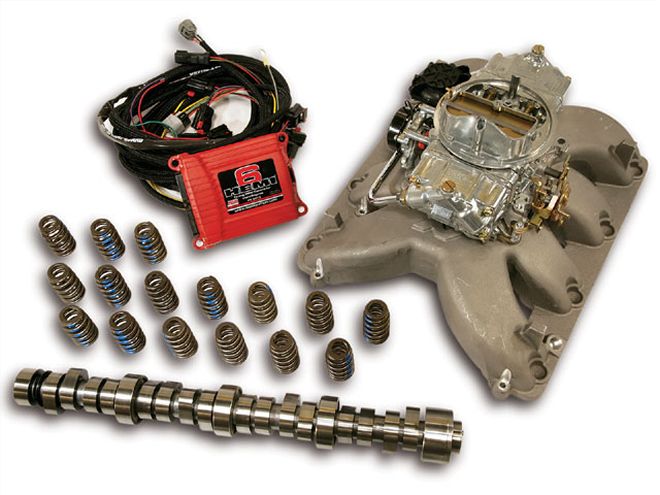 Want to drop some real Hemi power into your Mopar (or anything else)? Look no further than XV Motorsports for the components to make it happen. The key is XV's carbureted intake system and ignition controller, while further upgrades include cam and valvespring swaps for even more power.
Want to drop some real Hemi power into your Mopar (or anything else)? Look no further than XV Motorsports for the components to make it happen. The key is XV's carbureted intake system and ignition controller, while further upgrades include cam and valvespring swaps for even more power.
All this comparing and contrasting begs the question: Why build an old small-block when the Hemi has the goods? Really, a factory-stock 5.7 will put the hurt on a modestly built streetperformance LA or Magnum smallblock, and the output can rival a fairly serious effort on the older engine with a few mods to the Hemi. The answer seems to be that most Mopar guys would rather build on the old mill than deal with the wiring, computers, sensors, and EFI plumbing that come with the new engine. Even though the new Hemi has more power potential and used engines are becoming plentiful, the hassle of even thinking about making one of these modern engines run in an older car is turnoff enough.
What's the solution? Well, if all the troublesome installation issues are ironed out ahead of time, the Hemi swap becomes a sweet deal. This is where XV Motorsports comes in. First, the guys at XV looked at the injection question. Compared to bolting on a carb, working out a fuel-injection system is undeniably much more involved. For a majority of vintage Mopar fans, bolting on a carb and hooking up the fuel line is infinitely preferable to plumbing an EFI fuel system, with attendant wiring, regulators, pumps, and lines. Since the modern Hemi is throttle-by-wire, by the time all the EFI fuel system equipment and throttle body is tallied up, it is easy to be more invested in the support system than in the engine itself. A fat Holley sitting up center stage just looks right, while a aping throttle body up front seems all too wrong to traditionalists.
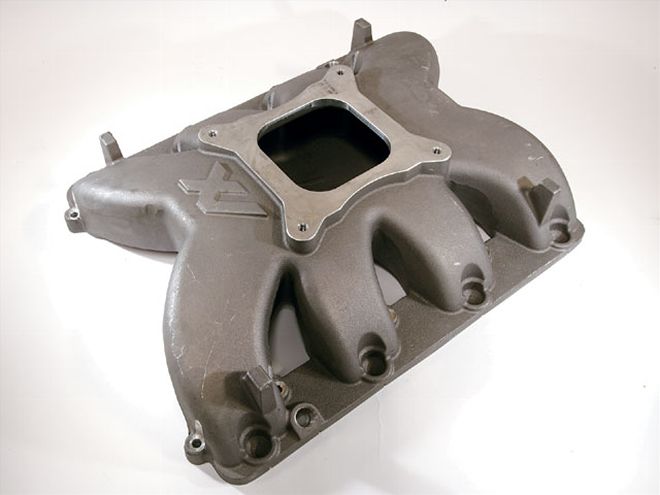 A difficulty in designing an effective manifold for the new-style Hemi is mating the vertical intake ports with a single four-barrel intake's horizontal port layout.
A difficulty in designing an effective manifold for the new-style Hemi is mating the vertical intake ports with a single four-barrel intake's horizontal port layout.
XV designed and cast a traditionalstyle, single-plane, four-barrel intake, making the swap to a carb a bolt-on. The manifold accepts a standard Holley 4150 carb in the conventional location. One of the design criteria was to retain a moderate overall height while maintaining a good transition in mating to the vertical intake ports of the Hemi heads. A shallow plenum and raised runners compared to other intakes on the market helped XV achieve this goal. This allows excellent hood clearance and compatibility with traditional Mopar scoops, air cleaners, and cold-air induction packages. There is no way to do that with a forward-facing throttle body. To up the ante further, XV can supply the carburetor already jetted and alibrated for the Hemi in various states of tune, from the base stock engine to XV's bigger cam packages delivering either a rated 400 or 420 hp.
The fuel system is just one side of the double-edged sword of installing a latemodel engine in a retrofit application. The other consideration is the ignition. If the fuel system seems problematic, the ignition and attendant wiring is enough to stop a Hemi swapper cold. With no distributor and 16 spark plugs, lighting the fire on a new Hemi presents a whole new set of questions. As with the induction solution, the idea at XV is to simplify the system for the end-user. Here, there's no way around a black box and wiring, but the ignition controller from XV simply plugs in where needed, and comes programmed and ready to run. With all the harness connections pre-terminated, solving the ignition requirement is simply a matter of mounting the box, plugging in the connections, and completing a twowire ground and power hookup. This ignition control unit comes calibrated with an ignition curve to match the engine package, though it is programmable by the end-user, or it can be reprogrammed by XV if further engine upgrades are performed.
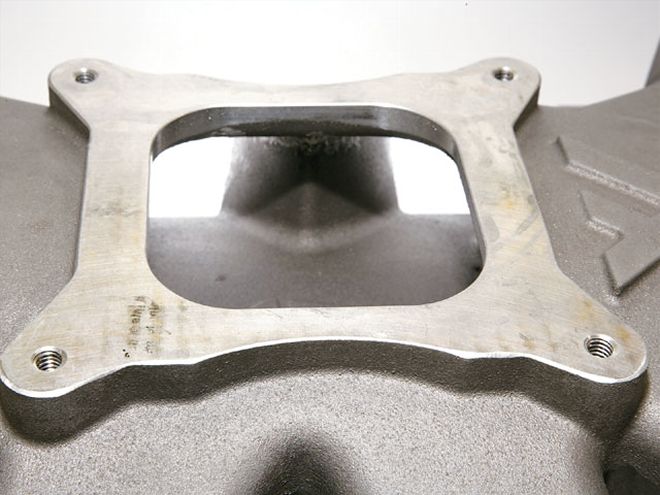 A wide, shallow plenum gives space for an effective "waterfall" into the runner, helping ease the transition into the cylinder head.
A wide, shallow plenum gives space for an effective "waterfall" into the runner, helping ease the transition into the cylinder head.
On The Dyno
So what is the easy power potential of the 5.7 Hemi? Some dyno time gave us an opportunity to investigate what these engines can do, and gave us the chance to see the XV equipment in operation. Our baseline combination was nothing more than a bone-stock 5.7 Hemi, the same package you'll find in your local salvage yard or core supplier. (We priced a practically new salvage unit from Street & Performance at $2,500, which is the cost benchmark in our "Where The Money Went" sidebar.) Just like a guy slinging one of these mills into an old Duster, we pulled the factory intake and bolted on the XV four-barrel intake manifold. No issues here; the swap comes down to a few bolts. Next, an XV-calibrated 650-cfm vacuum- secondary Holley carb was stacked on top, and we had an engine with the familiar look we know and love.
The crew at Westech Performance Group mounted the engine to thei SuperFlow 901 dyno, bolted on a set of dyno headers, and our next job was the ignition. Our Hemi was an earlier (pre- 2006) version with the crossover waste spark system, which fires the second plug on the exhaust stroke for emissions purposes. XV's kit comes with the required short spark plug wire, which connects the coil pack to the second plug of the same cylinder, firing both plugs simultaneously. We pulled the XV harness and controller from the pack, and it plugged right into the Hemi just as claimed, only requiring an additional ground and switched ignition connection. Hooking up this system makes the old Mopar electronic ignition look complicated. With that, we were assured that the engine was ready to run, and it was. Too easy.
With everything already precalibrated, there was nothing left to do but warm up the engine and pull the throttle handle for our power numbers. With he totally stock engine running through a set of headers and the XV intake, carb, and ignition, we were shocked by just how docile and smooth the engine sounded and ran. With the OEM cam, the stock idle was in sharp contrast to the formidable power we found. Peak power came in at 371 hp at 5,800-5,900 rpm, while peak torque was recorded at 366 lb-ft at 4,800 rpm. It just goes to show the power potential in those new Hemi heads; these kinds of numbers would require a fairly well-built oldstyle 360, with a fair bit of cam chop to get there.
XV conservatively rates the base engine package at 360 hp with the stock cam, but also offers upgraded packages, including more cam and the matching valvesprings, for ratings of 400 and 420 hp. The more powerful of these two packages, the XV Stage III, would be the subject of our next test. Featuring a COMP Cams camshaft with a rated advertised duration of 273/277 degrees, and measuring 224/228-degrees dura- tion at .050-inch tappet rise with .547/.550-inch lift, this is not a "wild" cam. Although considerably healthier than stock, the XV Stage III cam is moderate by conventional performance standards, especially in terms of duration. There was, however, the definite sound of performance, which was conspicuously absent with the OEM cam. To go along with the cam upgrade, the package also includes a set of uprated "beehive" valvesprings from COMP designed for the more aggressive valve action of the hotter stick. The ignition, carb, and intake setup remained the same, although the carb and spark calibration were changed to that offered for the Stage III package.
So what are a mild performance cam and the corresponding calibration worth in an otherwise all-stock 5.7 Hemi? As with the previous setup, the tuning was already done via the XV calibration, so all we needed to do was run for the numbers. Stout numbers they were, with peak horsepower now surging to 438 hp at 6,700 rpm, and peak torque recorded at 390 lb-ft at 5,200 rpm. The cam and spring change alone were worth a gain of 67 peak horsepower, and extended the useable rpm range by 900 rpm. We were impressed. Equally impressive was the fact that the added power did not come at the expense of torque, with peak torque increasing by a substantial 24 lb-ft. In fact, other than a slight loss in torque below 3,200 rpm, the larger camshaft got up and ran away from the output posted by the OEM cam combination. Unless you are building for a tow truck, there is little reason not to recommend the upgraded cam combination.
Swapping in Hemi power has never been easier with the components from XV, and one could argue that making Mopar power has never been cheaper or simpler. After all, we had a basically stock engine with a carb, intake, spring, and cam combo making a very streetable 438 hp. With the small-block of old, getting there would require head work, nasty levels of cam, or a combination of both. The new Hemi has unbelievable potential to offer for the streetbound Mopar. Unlocking that potential in a classic Mopar is as simple as turning the key with these parts from XV Motorsports. And the best part is that at the end of the day, you've got a Hemi to boot!
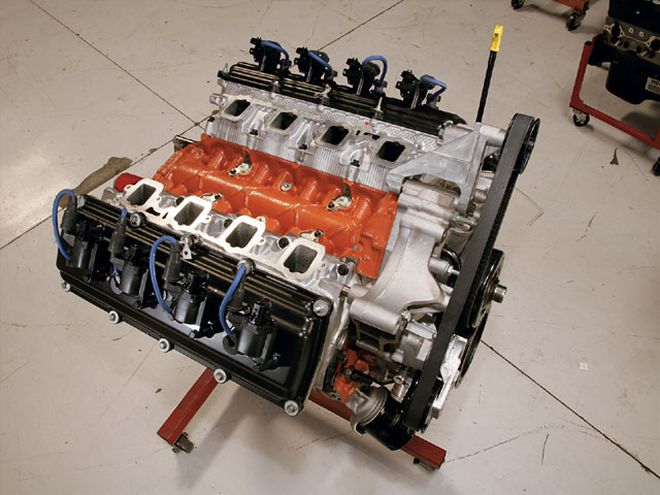
Finding A Hemi Core
Don't have a new Hemi lying around? All you need is a basic long-block like this one-you don't even need the computer, wiring harness, or even the fuel-injection manifold, for that matter. Even though they've only been produced since 2003, more than a million 5.7L Hemis have been turned out, so they're becoming more plentiful with each passing month. We had no problem finding them for sale on eBay and at core suppliers like Street & Performance (479-394-5711) for around $2,500.